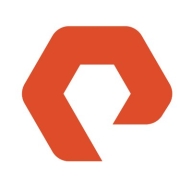


Red Hat Ceph Storage and NetApp StorageGRID compete in the enterprise storage market, each offering distinct advantages. Users find Red Hat Ceph Storage favorable for scalability and flexibility, whereas NetApp StorageGRID is preferred for its robust features and enterprise usability.
Features: Red Hat Ceph Storage offers a scalable architecture, open-source flexibility, and fault-tolerant design, appealing to businesses requiring customization. NetApp StorageGRID excels in advanced data lifecycle management, integrated tiering, and strong compliance features.
Room for Improvement: Red Hat Ceph Storage could enhance ease of deployment, user interface simplicity, and comprehensive support documentation. NetApp StorageGRID may improve on cost-effectiveness, user interface flexibility, and performance efficiency in high-demand scenarios.
Ease of Deployment and Customer Service: Red Hat Ceph Storage can face challenges during deployment, relying on an active support community. NetApp StorageGRID offers smoother deployment with polished integration services and dependable customer support.
Pricing and ROI: Red Hat Ceph Storage is cost-effective with favorable ROI, leveraging its open-source nature to reduce setup costs. NetApp StorageGRID incurs higher upfront expenses, justified by its features and performance, offering greater long-term value.
| Product | Market Share (%) |
|---|---|
| Red Hat Ceph Storage | 16.0% |
| Pure Storage FlashBlade | 5.2% |
| NetApp StorageGRID | 5.4% |
| Other | 73.4% |



| Company Size | Count |
|---|---|
| Small Business | 11 |
| Midsize Enterprise | 11 |
| Large Enterprise | 21 |
| Company Size | Count |
|---|---|
| Small Business | 5 |
| Midsize Enterprise | 4 |
| Large Enterprise | 11 |
| Company Size | Count |
|---|---|
| Small Business | 13 |
| Midsize Enterprise | 4 |
| Large Enterprise | 15 |
FlashBlade is the industry’s most advanced scale-out storage for unstructured data, powered by a modern, massively parallel architecture to consolidate complex data silos (like backup appliances and data lakes) and accelerate tomorrow’s discoveries and insights.
Store and manage unstructured data at scale using NetApp StorageGRID for secure, durable object storage. Place content in the right location, at the right time, and on the right storage tier, optimizing workflows and reducing overall costs for globally distributed rich media.
We monitor all File and Object Storage reviews to prevent fraudulent reviews and keep review quality high. We do not post reviews by company employees or direct competitors. We validate each review for authenticity via cross-reference with LinkedIn, and personal follow-up with the reviewer when necessary.